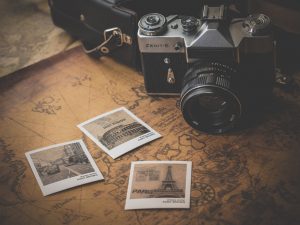
Visual Storytelling- The Fine Art Of Marketing
Natalie Ediger, October 23, 2019· Infographics
Visual stories as an effective communication strategy
After a long day you sit comfortably with your laptop on the couch and browse through the web. Your eyes suddenly get lost in an exciting title. You become curious. Your expectations rise. You look forward to this exciting information, a world-shattering message. You quickly click on the link to find out more. And woooom…! Nothing but a long text awaits you. A very long text. You scroll down once. Then up. And that’s it. As fast as you were on this page, as fast it is forgotten.
This case is probably a horror scenario for every marketing manager. Because the goal is always to retain the customer and to arouse his attention. The present case will neither bind long-term customer relationships nor increase your Google Ranking.
Today’s flood of information has led to a general preference for visual content over non-visual content. Hence, marketing specialists have to publish photos and videos in order for information to be perceived at all.
Therefore, this article is all about visual storytelling: What exactly is visual storytelling and how can marketing benefit from it? Which strategies should be considered in visual storytelling?

What is visual storytelling?
In our last article we presented the magic of storytelling as an effective marketing strategy. A good story, an exciting plot, characters to identify with: These are today indispensable marketing elements in order to win the customer on your side. Storytelling activates large parts of our brain which are responsible for the processing of emotions and experiences. Therefore, it is an ideal technique to reach the user with the information and stay in his mind.
But most people associate the term “storytelling” with purely spoken or written language. Our language, however, offers much more: Facial expressions, gestures, colours… all these are forms of our communication. The visual language by means of symbols, drawings and painting has even served as a versatile instrument for a very long time.
According to the motto “Show-don’t tell”, visual storytelling refers to, as the name suggests, telling stories with the help of visual media. For example, the story can be told using drawn or photographic images, illustrations or video. Not just a single statement is to be conveyed, but a story. This can be done with only one image or with several images that convey information. The story is created by the viewer himself through the respective context.
Why telling visual stories?
“A picture says more than a thousand words” – an omnipresent metaphor, meanwhile quoted to death. But it still emphasizes the core statement the best: A picture has a higher added value than a written text. Complicated facts are often explained more simply with a picture or a visual elements and usually leave a stronger impression than an extensive text. The importance of images and their narrative power increases especially in times of today’s sensory overload by the media.
Marketing based on textual messages and rational communication shows only little effect.

Benefits of visual storytelling
What exactly is different about pictures than text though? And why does visual storytelling offer companies completely new possibilities to retain customers in the long term? The most important features are summarized below:
(1) Visual information is processed faster
Ever heard of the Picture Superiority Effect? Research has shown that the human brain can process images 60,000 times faster than words. But why is this relevant for your marketing? Well, our goal is always to bind the customer… right?
A text consists of many symbols that first have to be decoded by the brain. This is a lot of work for and affects our attention spam. The high flow of information through media has drastically reduced our current absorption capacity anyway. It is therefore important to create content for your brand that conveys the most relevant information in the shortest possible time in an exciting way. Not that easy, hugh? But here we are again: “Visual storytelling” makes it happen by combining meaningful messages with story telling images.
(2) Setting yourself apart from the competition
Let’s take the Facebook news feed as an example: It is being updated every second… new content follows and follows and, yes follows. The typical Facebook user may take a few minutes to scroll through the feed. And that’s it. If you couldn’t arouse his curiosity during this period, you’ve already lost. Therefore, you have to develop content that attracts the full attention of the audience. Immediately.
Nowadays, it’s often just a glance that decides whether something is interesting or not. The first impressions are usually of visual nature. Hence, it is necessary to stand out from the crowd and reach and inspire people with exciting stories.The aim is to use narrative visuals to transport information far beyond the actual picture content and to create tension.
(3) More shares and reach
Do you privately use Facebook, LinkedIn or similar platforms? Then you’ve probably already gave a “thumbs up” a few times and also shared a post every now and then? How often was it pure text? And how often was it a picture or video? Engagement is not based on facts and figures, but on emotions! Studies have shown that images on social networks have a much higher interaction rate than content without images. Here are a few facts:
According to Hubspot, pictures on Twitter, for example, are shared 150% more often than pure text.
Articles with pictures are divided twice as often as articles without pictures.
Facebook posts get 2.3 times more engagement with visual content
Through Visual Storytelling you can reach larger audiences and increase your brand awareness.
(4) Emotional Connection
Take a look at the following picture:

Doesn’t your heart beat faster after that cuddly little puppy? Even cat lovers have to admit that you can hardly resist. Now imagine, instead of the picture, you would have read the following text: “A cute little puppy is looking at the camera”.
Would you feel the same as after looking at the picture? We doubt that. Most likely, you wouldn’t even react to this statement.
Texts deliver knowledge and background information (well, not exactly this example, but in general they do); however “visual narratives” convey emotions much more easily. Our brain doesn’t remember everything – just the most important things. Especially events that inspire us emotionally are stored in our long-term memory through specific synapses and the development of messenger substances.
And not to forget: The biggest of all purchasing decisions is made on an emotional level. This is why it is particularly important to engage with the audience emotionally.
(5) The imagery is universal
Unlike written or oral communication, we do not encounter a language barrier with stories of visual content. Of course, images can be interpreted differently depending on the culture, but generally images can reflect information in a universal language and in a creative way.
Visual Storytelling – effectively designed
Is it enough to just upload a lot of stock images to your channels every day? Absolutely not! Average pictures or pictures that only decorate text are not a good strategy for your visual storytelling, because … well… it’s not storytelling.
Pictures have to tell a story, according to the same principle as a written story. A picture that inspires, captivates, arouses emotions. One that lets the viewer participate in the plot, makes him the author of his own story, which he then associates with your brand.
A posing Instagram model with a product in her hand – there are many of them. But the goal is to create narrative images that can assert themselves in this media jungle. Make sure that the images are individual, meaningful and provide the company with recognition value.

The visual storytelling can also take on very different forms. Various media can be used for the visual narratives: photos, videos, infographics, etc. Of course, the design of your content should be in line with your corporate design, your brand image and your target group. What is important is that the aim of visual storytelling is to anchor a message that is associated with the brand.
Our conclusion
You can achieve a lot by using Visual Storytelling! More commitment, emotions, better information flow, more attention… and in the end more customers. Building an interactive community without narrative images will be very difficult today. Because people love stories and they love pictures. In order to be able to assert yourself successfully with your company today, you should therefore master the language of visual storytelling! Storytelling is itself a very effective instrument – but telling stories through pictures, that’s the fine art of marketing.
